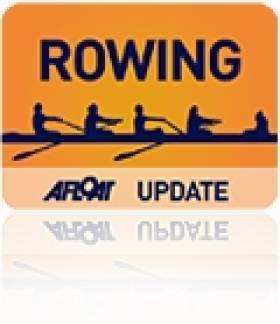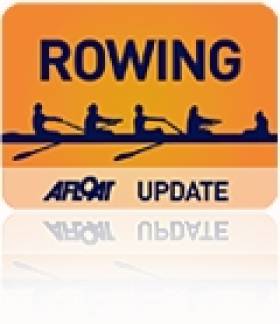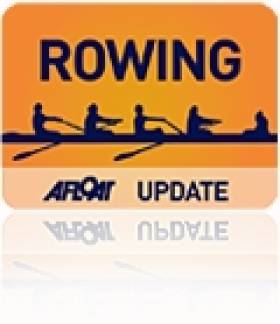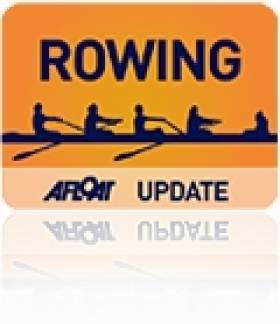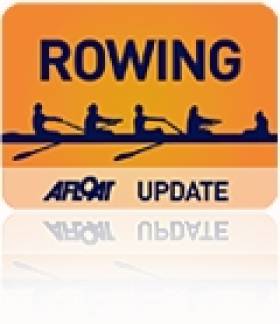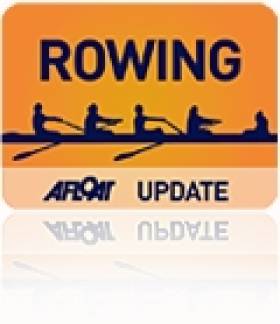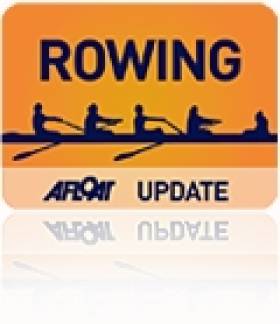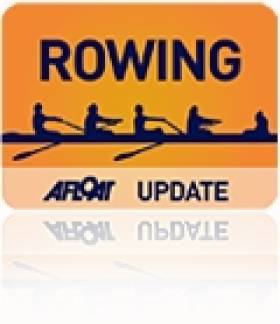Displaying items by tag: World Junior Championships
Good Start Not Enough for Ireland Women's Quadruple
#WorldJuniorRowing: Ireland had to settle for fifth place in the C Final, 17th overall, in the women’s quadruple sculls at the World Junior Rowing Championships at Trakai in Lithuania today. The crew of Fiona Murtagh, Jasmine English, Erin Barry and Bernadette Walsh had done well to make it through the C/D semi-finals and were very much in touch in the early stages, but by 750 metres they had dropped to the back of the field, and they stayed in fifth until the finish of a race won by Estonia.
World Junior Rowing Championships, Trakai, Lithuania, Day Four (Selected Results, Irish interest)
Men
Quadruple Sculls– C/D Semi-Final One (First Three to C Final; rest to D Final): 1 Romania 6:15.90, 2 Ukraine 6:17.57, 3 Ireland (C Carmody, J Mitchell, D O’Malley, P Hegarty) 6:18.28, 4 Russia 6:22.38, 5 Estonia 6:29.19.
Double Sculls – Semi-Final One (First Three to C Final; rest to D Final): 1 France 6:49.57, 2 Russia 6:50.65, 3 United States 6:50.83; 4 Ireland (A Harrington, J Casey) 6:51.05, 5 Bulgaria 6:59.84, 6 Estonia 7:06.97.
Women
Quadruple Sculls – C Final (places 13 to 17): 1 Estonia 7:07.80, 2 Japan 7:10.80, 3 Denmark 7:12.25, 4 Sweden 7:12.30,
5 Ireland (F Murtagh, J English, E Barry, B Walsh) 7:25.01
Ireland Junior Quadruple Does Business at World Rowing
#WorldJuniorRowing: Ireland’s quaduple scull of Conor Carmody, John Mitchell, David O’Malley and Paddy Hegarty raced a good race to finish third in their C/D Semi-Final and qualify for the C Final at the World Junior Rowing Championships in Trakai in Lithuania this morning. Romania were virtually unchallenged as leaders through this race, with the Ukraine, Ireland and Russia disputing the second and third qualification places. In the final quarter Ireland took on and beat the Russians to secure third.
The C/D semi-final for the Ireland men’s double of Jack Casey and Andy Harrington had been a very similar race, but Ireland came out at the wrong end of the result. France led all the way down the course, with Ireland, Russia and Bulgaria vying for second and third. Ireland moved into second by the third quarter but the United States challenged strongly over the final half and engaged in a battle with Russia. As Bulgaria faded, Russia and the United States took second and third, while Ireland fell back to fourth.
World Junior Rowing Championships, Trakai, Lithuania, Day Four (Selected Results, Irish interest)
Men
Quadruple Sculls– C/D Semi-Final One (First Three to C Final; rest to D Final): 1 Romania 6:15.90, 2 Ukraine 6:17.57, 3 Ireland (C Carmody, J Mitchell, D O’Malley, P Hegarty) 6:18.28, 4 Russia 6:22.38, 5 Estonia 6:29.19.
Double Sculls – Semi-Final One (First Three to C Final; rest to D Final): 1 France 6:49.57, 2 Russia 6:50.65, 3 United States 6:50.83; 4 Ireland (A Harrington, J Casey) 6:51.05, 5 Bulgaria 6:59.84, 6 Estonia 7:06.97.
Ireland Women's Quadruple Shows Fighting Spirit
#WorldJuniorRowing: The Ireland women’s quadruple, which has struggled at the World Junior Rowing Championships in Trakai in Lithuania, showed fighting spirit to take third in their C/D Semi-Final today.
Denmark and Japan secured first and second, but the young Ireland crew of Bernadette Walsh, Fiona Murtagh, Erin Barry and Jasmine English saw off a challenge by Croatia in the middle stages of the race to secure qualification for the C Final for places 13 to 18.
World Junior Rowing Championships, Trakai, Lithuania, Day Three (Selected Results, Irish interest)
Men
Double Sculls – Quarter Final One (First Three to A/B Semi-Final; rest to C/D Semi-Final): 1 Romania 6:21.73, 2 Lithuania 6:25.62, 3 Britain 6:26.80; 4 Russia 6:36.37, 5 Croatia 6:40.91, 6 Ireland (A Harrington, J Casey) 6:41.41.
Women
Quadruple Sculls – C/D Semi-Final (First Three to C Final; rest to D Final): 1 Denmark 6:57.12, 2 Japan 6:58.13, 3 Ireland (B Walsh, F Murtagh, E Barry, J English) 7:03.58; 4 Croatia 7:08.50.
#WorldJuniorRowing: The Ireland men’s double scull of Jack Casey and Andy Harrington missed out on a place at the semi-finals at the World Junior Rowing Championships at Trakai in Lithuania this morning. In tailwind conditions, Romania set a hot pace in the quarter-final, with Britain and Lithuania coming closest to matching them. The first three places were the crucial ones and Ireland were in touch to half way. But in the second half, the top three moved away and Ireland ended up sixth. Lithuania took second from Britain coming up to the line.
World Junior Rowing Championships, Trakai, Lithuania, Day Three (Selected Results, Irish interest)
Men
Double Sculls – Quarter Final One (First Three to A/B Semi-Final; rest to C/D Semi-Final): 1 Romania 6:21.73, 2 Lithuania 6:25.62, 3 Britain 6:26.80; 4 Russia 6:36.37, 5 Croatia 6:40.91, 6 Ireland (A Harrington, J Casey) 6:41.41.
Ireland Double Shoots Into Semis at World Junior Rowing
#WorldJuniorRowing: Ireland’s Bridget Jacques and Hilary Shinnick qualified for the semi-finals of the women’s double sculls at the World Junior Rowing Championships with an emphatic win in Trakai in Lithuania this morning. Two boats qualified, but Ireland left second-placed Austria far behind, with a the margin a remarkable 14.51 seconds at the finish.
The men’s quadruple fought a great fight and came within 12 hundredths of a second of qualifying for their semi-finals. The race was won well by Germany, and Poland held the second qualifying place down the course, holding off challenges by Japan and the Ireland crew of Conor Carmody, John Mitchell, David O’Malley and Patrick Hegarty. In the hectic closing stages Ireland were just held off by Poland.
The women’s quadruple scull of Bernadette Walsh, Jasmine English, Erin Barry and Fiona Murtagh will compete in the C/D semi-finals after finishing fifth of five in their repechage. Switzerland and Belarus comfortably took the qualifying places for the A/B semi-finals, while Ireland finished behind Japan and Estonia, who took third and fourth.
World Junior Rowing Championships, Trakai, Lithuania, Day Two (Selected Results, Irish interest)
Men
Quadruple Sculls (First Two to A/B Semi-Finals; rest to C/D Semi-Finals) – Repechage One: 1 Germany 6:28.81, 2 Poland 6:35.94; 3 Ireland (C Carmody, J Mitchell, D O’Malley, P Hegarty) 6:36.06, 4 Japan 6:37.20, 5 Estonia 6:53.89.
Women
Quadruple Sculls (First Two to A/B Semi-Finals; rest to C/D Semi-Finals) – Repechage Two: 1 Switzerland 7:04.23, 2 Belarus 7:10.38; 3 Japan 7:14.75, 4 Estonia 7:17.39, 5 Ireland (B Walsh, F Murtagh, E Barry, J English) 7:27.52.
Double Sculls (First Two to A/B Semi-Finals; rest to C/D Semi-Finals) – Repechage Four: 1 Ireland (H Shinnick, B Jacques) 8:11.85, 2 Austria 8:26.36; 3 Mexico 8:36.29, 4 Moldova 8:42.35, 5 Israel 8:58.95
Shinnick and Jacques in Dramatic Finish at World Junior Rowing
#WorldJuniorRowing: The Ireland women’s double scull of Bridget Jacques and Hilary Shinnick had to settle for second place and a slot in a repechage at the World Junior Championships in Trakai in Lithuania today. The very promising crew were leading their heat with about 100 metres to go and on course for direct qualification for the semi-finals when they clipped a buoy and temporarily lost control of an oar. Greece, who were less than a length down, came through and won by 3.73 seconds.
The Ireland men’s double of Andy Harrington and Jack Casey also finished second in their heat, to progress to their quarter-final, while the men’s quadruple finished fourth in a race in which all the crews except the winners, the Czech Republic, move on to the repechages.
The Ireland women’s quadruple finished fourth in their heat. South Africa and the Czech Republic took charge early on and took the two direct qualification places for the semi-final. Sweden and Ireland were third and fourth down the course and finished well behind. India did not compete.
World Juniors Rowing Championships, Trakai, Lithuania, Day One (Selected Results, Irish interest)
Men
Quadruple Sculls (First to A/B Semi-Finals; rest to Repechage) – Heat Two: 1 Czech Republic 6:22.66; 2 Italy 6:26.11, 3 China 6:26.77, 4 Ireland (C Carmody, J Mitchell, D O’Malley, P Hegarty) 6:36.07, 5 Greece 6:39.68, 6 Austria 6:50.63.
Double Sculls – (First Four to Quarter-Finals) – Heat Five: 1 Denmark 7:07.58, 2 Ireland (J Casey, A Harrington) 7:09.75, 3 United States 7:12.03, 4 Belarus 7:15.68; 5 China 7:26.92.
Women
Quadruple Sculls – Heat Two (First Two to A/B Semi-Finals; rest to Repechages): 1 South Africa 7:12.61, 2 Czech Republic 7:14.43; 3 Sweden 7:27.46, 4 Ireland (B Walsh, F Murtagh, E Barry, J English) 7:34.18.
Double Sculls – (First To A/B Semi-Finals, Rest to Repechages) – Heat Four: 1 Greece 7:41.64, 2 Ireland (H Shinnick, B Jacques) 7:45.37, 3 Croatia 7:54.35, 4 Germany 8:07.68, 5 Uzbekhistan 8:20.83, 6 Moldova 8:29.47.
# ROWING: A team of 13 Ireland hopefuls will travel to the World Junior Championships this season. Hilary Shinnick and Bridget Jacques team up in a promising junior double scull, and Bernadette Walsh will represent Ireland in the single scull in Lithuania.
Ireland will also take big teams to the Coupe de la Jeunesse in Lucerne, Switzerland, in August and the Home International Regatta in Nottingham in July.
| Junior World Championships, Trakai, Lithuania (7-11 August) |
|---|
| JW 1X Bernadette Walsh (Skibbereen RC) |
| JW 2X Hilary Shinnick (Fermoy RC), Bridget Jacques (Belfast BC) |
| JW 4X- Fiona Murtagh (Galway RC), Leonie Hamel (Cork BC), |
| Erin Barry (Bann RC), Jasmin English (Belfast BC) |
| JM 2X Andy Harrington (Shandon BC), Jack Casey (Shandon BC) |
| JM 4X- Paddy Hegarty (Skibbereen RC), John Mitchel (Lee RC), |
| David O’Malley (St Michaels RC), Conor Carmody (Shannon RC) |
| Coupe de la Jeunesse, Lucerne, Switzerland (2-4 August) |
| JW 1X Phoebe Mulligan (Portora BC) |
| JW 2X Megan McLaughlin (Cork BC), Claire Beechinor (Cork BC) |
| JW 4X- Kara O’Connor (Muckross RC), Eimear Lambe (Commercial RC), |
| Laura Kilbane (Cork BC), Zoe Hyde (Killorglin RC) |
| JM 1X Gareth McKillen (RBAI RC) |
| JM 2X William Yeomans (Commercial RC), Daniel Buckley (Lee RC) |
| JM 4X- Matthew Ryan (Skibbereen RC), Rory O’Sullivan (Lee RC), |
| Evan Stone (Lee RC), Stephen Murphy (Cork BC) |
| The following two crews will undergo further assessment before making a final decision for the Coupe de la Jeunesse team. |
| JM 4- Kevin Fallon (St Josephs RC), Jack Smyth (St Josephs RC), |
| David Keohane (Presentation), Brian Keohane (Presentation) |
| JW 4- Lauren McHugh (Shannon RC), Clodagh Scannell (Shandon BC), |
| Daisy Callanan (Shandon BC), Ruth Gilligan (Shannon RC). |
Home International, Nottingham, July 27th
Men – Junior, Sweep: C Hennessy, L Carroll, E Murray, K Anderson, R McKenna, A Chadfield (plus four to be chosen). Sculling: N McCarthy, E Whittle, K Keohane, D Synnott, S Kearney (plus two to be decided). Women – Junior, Sweep: V Sheehan, Z Madden, K Healy, E Coll, H McCarthy, A Luke (plus four to be chosen). Sculling: S Murphy, K Turner, C O’Sullivan, C Kelly, Z Sohun, A Griffin (plus one other).
Hughes 10th Overall at World Junior Champs
Turlough Hughes finished fourth in the B Final of the men’s single sculls at the World Junior Championships in Racice in the Czech Republic this morning. Portugal’s Tome Perdigao won a battle with Serbia’s Alexsandar Filipovic at the head of the field, while Hughes lost out for third to Lithuania’s Zygimantas Galisanskis. The Irishman’s performance gave him 10th overall at the Championships.
Junior World Championships, Racice, Czech Republic. Day Four (Irish interest)
Men’s Single Scull – B Final (Places 7-12): 1 Portugal (T Perdigao) 7:17.15, 2 Serbia (A Filipovic) 7:19.04, 3 Lithuania (Z Galisanskis) 7:19.13, 4 Ireland (T Hughes) 7:20.51, 5 Croatia 7:21.58, 6 Estonia 7:25.10


























